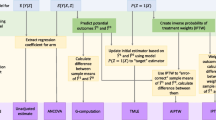Abstract
While there is broad consensus on analytic techniques for adjusting for covariates at baseline, the situation for covariates arising postrandomization is considerably more difficult. Examples include the level of patient “compliance” measured through pill counts and other biochemical markers, the occurrence of missing data over patient followup, and early withdrawal from medication. The “intention-to-treat” (ITT) principle requires that all randomized patients be included in all analyses irrespective of their confounder experience. This approach, however, seems at odds with good scientific method and is a considerable source of friction with medical investigators. In this paper, we review the interpretation of this analysis strategy and suggest that the statistical community has been careless in its interpretation of these results. We outline a conservative strategy that is consistent with ITT principles. Nevertheless, any analysis that adjusts for these covariates must be considered speculative in nature and followed by a properly designed confirmatory study. For this reason, we argue that these analyses are of greater relevance early in a drug development program.
Similar content being viewed by others
References
Wickramaratne PJ, Holford TR. Confounding in epidemiologic studies: The adequacy of the control group as a measure of confounding. Biometrics. 1987;43:751–765.
Miettinen OS, Cook EF. Confounding: essence and detection. Am J Epidemiol. 1981;114:593–603.
Oakes D, Moss AJ, Fleiss JL, Bigger JT, Therneau T, Eberly SW, McDermott MP, Manatunga A, Carleen E, Benhorin J. Use of compliance measures in an analysis of the effect of Diltiazem on mortality and reinfarction after myocardial Infarction. J Am Stat Assoc. 1993;88:44–49.
Andersen PK. Time-dependent covariates and Markov processes. In: Moolgavkar SH, Prentice RL, eds. Modern Statistical Methods in Chronic Disease Epidemiology. New York, NY: John Wiley & Sons; 1986:82–103.
Efron B, Feldman D. Compliance as an explanatory variable in clinical trials (with discussion). J Am Stat Assoc. 1991;86:9–26.
Robins J. The analysis of randomized and nonran-domized AIDS treatment trials using a new approach to causal inference in longitudinal studies. In: Sechrest L, Freeman H, Mulley A, eds. Health Service Research Methodology: A Focus on AIDS. Washington, DC: NCHSR, U.S. Public Health Service; 1989: 113–159.
Robins JM, Tsiatis AA. Correcting for non-compliance in randomized trials using rank preserving structural failure time models. Comm Stat Theory Meth. 1991;20:2609–2631.
Mark SD, Robins JM. A method for the analysis of randomized trials with compliance information: an application to the Multiple Risk Factor Intervention Trial. Control Clin Trials. 1993;14:79–97.
Robins JM. Correcting for non-compliance in randomized trials using structural nested mean models. Comm Stat Theory Meth. 1994;23:2379–2412.
Wu MC, Bailey KR. Estimation and comparison of changes in the presence of informative censoring: conditional linear model. Biometrics. 1989;45:939–955.
Wu MC, Carroll RJ. Estimation and comparison of changes in the presence of informative right censoring by modeling the censoring process. Biometrics. 1988;44:175–188.
Diggle P. Informative dropout in longitudinal data analysis (with discussion). Appl Stat. 1994;43: 49–93.
Robins J, Greenland S. Adjusting for differential rates of prophylaxis therapy for PCP in high- versus low-dose AZT treatment arms in an AIDS randomized Trial. J Am Stat Assoc. 1994;89:737–749.
Rochon J. Supplementing the Intent-To-Treat analysis: accounting for covariates observed post randomization in clinical trials. J Am Stat Assoc. 1995;90: 292–300.
Rochon J. Accounting for covariates observed post randomization for discrete and continuous repeated measures data. J Roy Stat Soc B. 1996;58:205–219.
Yusuf S, Wittes J, Probstfield J, Tyroler HA. Analysis and interpretation of treatment effects in subgroups of patients in randomized clinical trials. JAMA. 1991;266:93–98.
Rochon J. Analyzing bivariate repeated measures for discrete and continuous outcome variables. Biometrics. 1996;52:740–750.
Author information
Authors and Affiliations
Corresponding author
Rights and permissions
About this article
Cite this article
Rochon, J. Issues in Adjusting for Covariates Arising Postrandomization in Clinical Trials. Ther Innov Regul Sci 33, 1219–1228 (1999). https://doi.org/10.1177/009286159903300425
Published:
Issue Date:
DOI: https://doi.org/10.1177/009286159903300425



